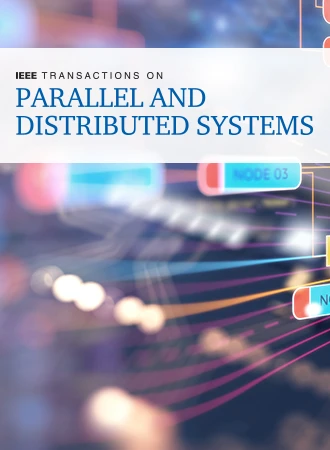HRCM:全人脑模拟中稀疏和不平衡通信的分层正则化机制
IF 5.6
2区 计算机科学
Q1 COMPUTER SCIENCE, THEORY & METHODS
IEEE Transactions on Parallel and Distributed Systems
Pub Date : 2024-04-12
DOI:10.1109/TPDS.2024.3387720
引用次数: 0
摘要
大脑模拟是了解大脑如何表示和处理信息的最重要措施之一,通常需要在具有大量互连图形处理单元(GPU)的超级计算机中实现。对于整个人类大脑的模拟,需要利用数以万计的 GPU 来模拟活体大脑的数百亿个神经元和数万亿个突触,以揭示功能连接模式。然而,作为不规则备件通信问题在大规模系统上的应用,人脑稀疏且不平衡的通信模式使得设计支持大规模大脑模拟的通信系统尤为困难。面对这一挑战,本文提出了一种分层正则化通信机制(HRCM)。HRCM 采用合并前向算法维护分层虚拟通信拓扑(HVCT),利用神经元交互的稀疏性来规范大脑模拟中的进程间通信。HRCM 还提供了神经元级分区方案,用于将神经元分配给仿真进程,以平衡通信负载,同时提高资源利用率。在 HRCM 中,神经元分区被表述为 k 路图分区问题,并通过所提出的混合多约束贪婪(HMCG)算法高效解决。HRCM 已在运行于 10000 个 GPU 上的高达 860 亿神经元规模的人脑仿真中实现。大量仿真实验的结果验证了 HRCM 在大幅减少通信延迟、提高资源利用率和缩短大规模人脑模型仿真时间方面的有效性。本文章由计算机程序翻译,如有差异,请以英文原文为准。
HRCM: A Hierarchical Regularizing Mechanism for Sparse and Imbalanced Communication in Whole Human Brain Simulations
Brain simulation is one of the most important measures to understand how information is represented and processed in the brain, which usually needs to be realized in supercomputers with a large number of interconnected graphical processing units (GPUs). For the whole human brain simulation, tens of thousands of GPUs are utilized to simulate tens of billions of neurons and tens of trillions of synapses for the living brain to reveal functional connectivity patterns. However, as an application of the irregular spares communication problem on a large-scale system, the sparse and imbalanced communication patterns of the human brain make it particularly challenging to design a communication system for supporting large-scale brain simulations. To face this challenge, this paper proposes a hierarchical regularized communication mechanism, HRCM. The HRCM maintains a hierarchical virtual communication topology (HVCT) with a merge-forward algorithm that exploits the sparsity of neuron interactions to regularize inter-process communications in brain simulations. HRCM also provides a neuron-level partition scheme for assigning neurons to simulation processes to balance the communication load while improving resource utilization. In HRCM, neuron partition is formulated as a k-way graph partition problem and solved efficiently by the proposed hybrid multi-constraint greedy (HMCG) algorithm. HRCM has been implemented in human brain simulations at the scale of up to 86 billion neurons running on 10000 GPUs. Results obtained from extensive simulation experiments verify the effectiveness of HRCM in significantly reducing communication delay, increasing resource usage, and shortening simulation time for large-scale human brain models.
求助全文
通过发布文献求助,成功后即可免费获取论文全文。
去求助
来源期刊

IEEE Transactions on Parallel and Distributed Systems
工程技术-工程:电子与电气
CiteScore
11.00
自引率
9.40%
发文量
281
审稿时长
5.6 months
期刊介绍:
IEEE Transactions on Parallel and Distributed Systems (TPDS) is published monthly. It publishes a range of papers, comments on previously published papers, and survey articles that deal with the parallel and distributed systems research areas of current importance to our readers. Particular areas of interest include, but are not limited to:
a) Parallel and distributed algorithms, focusing on topics such as: models of computation; numerical, combinatorial, and data-intensive parallel algorithms, scalability of algorithms and data structures for parallel and distributed systems, communication and synchronization protocols, network algorithms, scheduling, and load balancing.
b) Applications of parallel and distributed computing, including computational and data-enabled science and engineering, big data applications, parallel crowd sourcing, large-scale social network analysis, management of big data, cloud and grid computing, scientific and biomedical applications, mobile computing, and cyber-physical systems.
c) Parallel and distributed architectures, including architectures for instruction-level and thread-level parallelism; design, analysis, implementation, fault resilience and performance measurements of multiple-processor systems; multicore processors, heterogeneous many-core systems; petascale and exascale systems designs; novel big data architectures; special purpose architectures, including graphics processors, signal processors, network processors, media accelerators, and other special purpose processors and accelerators; impact of technology on architecture; network and interconnect architectures; parallel I/O and storage systems; architecture of the memory hierarchy; power-efficient and green computing architectures; dependable architectures; and performance modeling and evaluation.
d) Parallel and distributed software, including parallel and multicore programming languages and compilers, runtime systems, operating systems, Internet computing and web services, resource management including green computing, middleware for grids, clouds, and data centers, libraries, performance modeling and evaluation, parallel programming paradigms, and programming environments and tools.
 求助内容:
求助内容: 应助结果提醒方式:
应助结果提醒方式:


